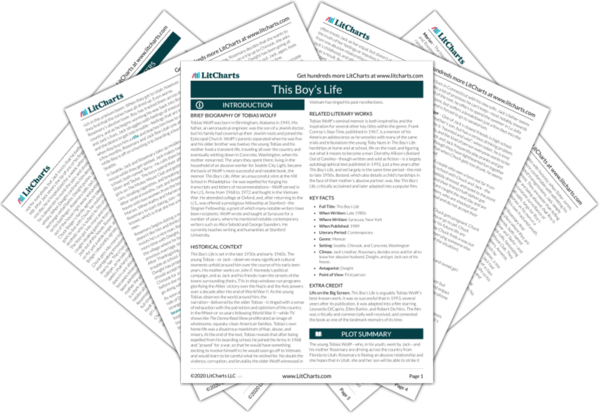When Jack moves into Dwight’s home, he finds himself subject to abuse and manipulation of all kinds—physical, emotional, and psychological. Dwight berates Jack for being lazy, selfish, deceitful, and useless; in order to assert his control and authority over the young boy, he forces him into community activities (so that Jack’s time is always occupied with engagements prescribed directly by Dwight himself) and menial, difficult tasks (so that Jack feels like a servant in his own home.) One of the tasks is shucking horse chestnuts, which are encased in hard, spiky, stinky shells, the removal of which stains Jack’s hands yellow and embarrasses him at school. Dwight also forces Jack to endure and look at acts of violence—while driving home one afternoon, Dwight purposefully swerves to hit a beaver crossing the road. Dwight orders Jack to pick up the dead, bleeding beaver; its pelt, he says, is worth a lot of money. Jack refuses to touch the beaver, and Dwight berates him for being afraid of something that’s “just meat.” Dwight himself picks up the beaver, puts it in the trunk, and carts it home; the incident is quickly forgotten as just another dark and manipulative episode in Jack and Dwight’s checkered relationship. Almost two years later, Dwight urges Jack to follow him up to the attic so they can finally eat the chestnuts which Jack once worked so hard to shuck; one they were cleaned, Dwight put them away, seemingly to make Jack feel even more thankless and useless. As the two of them climb up to the attic, Jack sees that the box in which the chestnuts were stored has bloomed with mold; it is puffed out of the top “like dough swelling out of a breadpan.” When Dwight shines his flashlight across the attic, Jack spots something even more horrifying; the basin where the beaver, “also forgotten,” has been left to “cure”—the carcass, however, has turned into a “pulp” covered with a white, transparent kind of mold that has “flowered to a height of two feet or so.”
The discovery of the moldy chestnuts and decomposed beaver shows how deeply and acutely Dwight has been abusing and manipulating Jack for the last two years. Jack has been forced to endure humiliating and even painful tasks, and has been shamed when he’s failed to do exactly what Dwight has wanted him to do; now, in the dark of the attic, Jack sees how little these things actually matter to Dwight. Dwight never wanted chestnuts for the family to eat, or a valuable pelt to sell; he simply wanted to control Jack, subjugate him to his own will, and break his spirit. In the attic, Jack finally sees the chestnuts and beavers—horribly rotted and barely recognizable—as tangible symbols of the abuse he has suffered. Their decomposed state reflects the broken, irreparable relationship between Jack and Dwight, and the ways in which Dwight’s malice has seeped into every aspect of Jack’s life, infecting all it touches.
The Chestnuts and the Beaver Quotes in This Boy’s Life
I wanted to do what Dwight expected me to do, but I couldn't. I stood where I was and stared at the beaver. Dwight came up beside me. "That pelt's worth fifty dollars, bare minimum." He added, "Don't tell me you're
afraid of the damned thing."
"No sir."
"Then pick it up." He watched me. "It's dead, for Christ's sake. It's just meat. Are you afraid of hamburger? Look." He bent down and gripped the tail in one hand and lifted the beaver off the ground. He tried to make this appear effortless but I could see he was surprised and strained by the beaver's weight. A stream of blood ran out of its nose, then stopped. A few drops fell on Dwight's shoes before he jerked the body away. Holding the beaver in front of him with both hands, Dwight carried it to the open trunk and let go. It landed hard. "There," he said, and wiped his hands on his pant leg.
We climbed up into the attic and worked our way down to where I'd put the boxes. It was cramped and musty. From below I could hear faint voices singing. Dwight led the way, probing the darkness with a flashlight. When he found the boxes he stopped and held the beam on them. Mold covered the cardboard sides and rose from the tops of the boxes like dough swelling out of a breadpan. Its surface, dark and solid-looking, gullied and creased like cauliflower, glistened in the light. Dwight played the beam over the boxes, then turned it on the basin where the beaver, also forgotten these two years past, had been left to cure. Only a pulp remained. This too was covered with mold, but a different kind than the one that had gotten the chestnuts. This mold was white and transparent, a network of gossamer filaments that had flowered to a height of two feet or so above the basin. It was like cotton candy but more loosely spun. And as Dwight played the light over it I saw something strange. The mold had no features, of course, but its outline somehow suggested the shape of the beaver it had consumed: a vague cloud-picture of a beaver crouching in the air.












